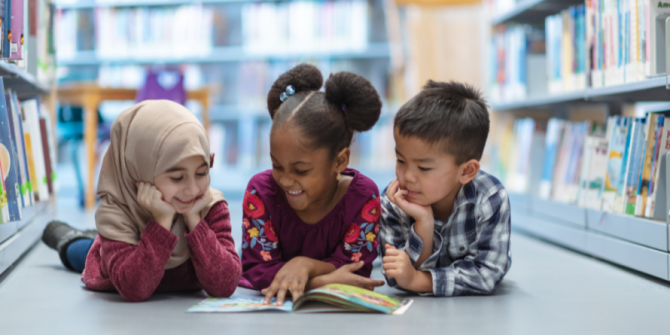Although children may not have the language or knowledge to understand racism and oppression to the same extent as adults, we still have the ability and responsibility to acknowledge, name and discuss racism with children. Talking about race, power and privilege can help even young children see how systems do not serve all people equally.

Too often we teach kids to be colourblind (aka not to pay attention to skin colour) and although equality is the ultimate goal, we need to acknowledge this goal hasn’t been achieved and race (as well as gender, class, sexual orientation and physical ability) make very real impacts on people’s lives. Even young children from ages 3-5 notice and start to develop concepts around emotion, safety and fairness, so these are great starting points to talk about racism with your children. These conversations can evolve in complexity as children grow. Kids are never too young to talk about race.
Books and stories are a useful tool for starting these conversations and building empathy and understanding. We've created a list of children’s books that help kids grapple with the concept of racism.
Also important is making diverse books a part of children’s regular reading habits. Books by and about Black, Indigenous and People of Colour help children see what it’s like to walk in someone else’s shoes, even if the books aren’t explicitly about racism.
Why Diversity is Important in Children’s Books
As Rudine Sims Bishop [1] has written, books can serve as windows and mirrors for their readers. Children need books that are windows — opportunities to see worlds and experiences different from their own — as well as mirrors — stories and characters that reflect, validate and celebrate their own lived experiences. For children from traditionally underrepresented communities, books too often serve as windows and rarely act as mirrors. This is one of the many reasons we need diverse books.
“Diverse books empower, vindicate, normalize, and make visible readers who might otherwise feel forgotten, invisible, or like they’re imposters whose stories don’t deserve to be told. Everyone deserves to see themselves in books.” [2]
Too Few Diverse Children’s Books
Assessments of diversity in children’s books performed by the Cooperative Children’s Book Center (CCBC) [3] have continually found that diverse characters are starkly underrepresented in children’s books. Although diverse representation in children’s books is increasing over time, children’s books still predominantly feature white, able-bodied, gender- and hetero-normative characters. For example:
- Only 26% of the 3,134 books received by the CCBC in 2018 are about Indigenous characters or characters of colour
- Only 3.4% of the 3,700 books received at the CCBC in 2017 featured a queer character or LGBTQ+ family
How to Choose Diverse Books
When looking to borrow or purchase diverse books, consider books:
- By Own voice authors: Selecting diverse stories with main characters from unrepresented groups written by authors from those same underrepresented groups— known as Own voice — provides readers with authentic and accurate narratives. It also supports these writers and gives them space in our bookshelves, our thoughts and our lives. You can find ‘Own voice’ children’s books using Novelist.
- With characters that reflect more than one marginalized group: A young girl of colour will have a different experience than a young boy of colour; a transgender person of colour will have a different experience than a transgender person who is white — this is known as intersectionality. Even within marginalized groups there are even smaller pockets of people whose stories are never heard. Instead of reading one book to children and letting that book represent the entirety of one group’s experience, reading widely and from multiple authors, including authors who straddle multiple marginalized identities, will give a broader, more nuanced understanding.
- That emphasize joy, not simply trauma: Often stories about underrepresented groups focus on topics like harm, suffering or trauma. Although these stories are important, we must also ensure to choose books that showcase marginalized groups as regular people who have celebrations, moments of laughter and joy.
Not sure where to get started? Here’s a list of Own voices authors created by the Seattle Public Library. We are working hard to obtain as many of these titles in eBook format as we can!
Responding to Problematic Stereotypes or Narratives
Research indicates that children develop racial biases as young as age three. They get it from sources including media and books [4]. Inevitably, we will encounter books with problematic narratives or harmful stereotypes. These can serve as teachable moments to engage in age-appropriate discussions about racism, homophobia, ableism and other harmful views that can be embedded (explicitly or subtly) within stories. Don’t just gloss over them! Stop and ask your children if this seems like it’s fair or accurate, and why the author may have chosen to write something like this.
Feeling intimidated? The National Museum of African American History and Culture has great resources for talking about race and injustice with children.
For adult-focused content check out our list:
[1] Bishop, R. S. (1990). Mirrors, windows, and sliding glass doors. Perspectives: Choosing and Using Books for the Classroom: 6(3).
[2] Barcellona, C. (2015). Six reasons why we need diverse books. Swoon Reads.
[3] Data on books by and about people of color and from First/Native Nations published for children and teens compiled by the Cooperative Children’s Book Center, School of Education, University of Wisconsin-Madison.
[4] Van Ausdale, D., & Feagin, J. R. (2001). The first R: how children learn race and racism. Lanham, MD.: Rowman & Littlefield.


Add a comment to: How to Help Children Understand Anti-Racism and Diversity Through Books